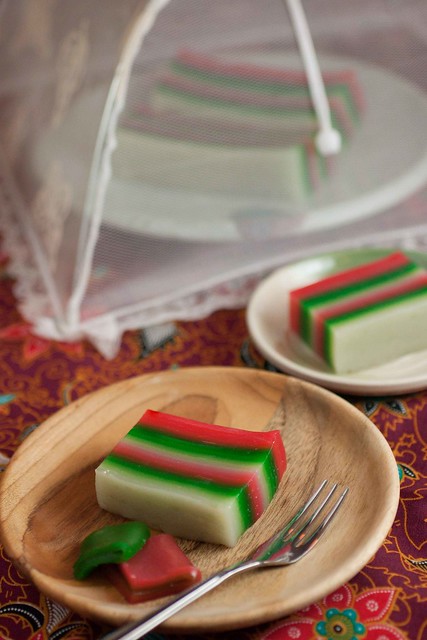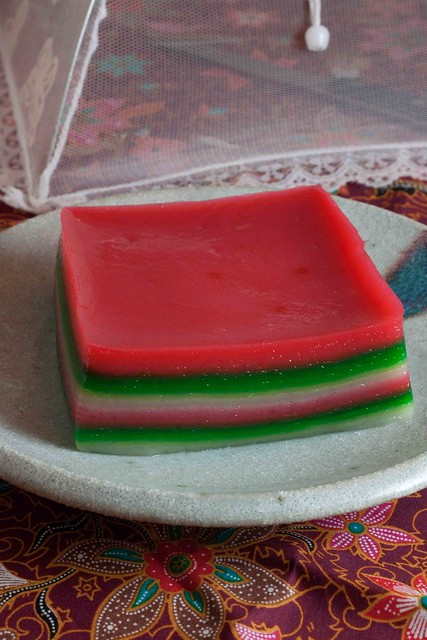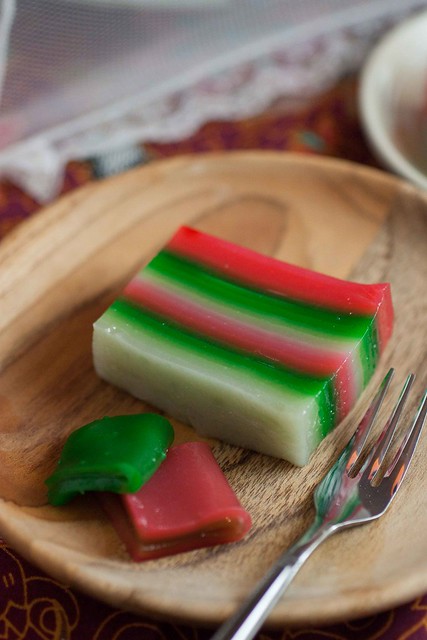

Singapore's National Day falls on 9th August. We are 46 this year and I thought it appropriate to celebrate the month of August with a little Heritage treat that we all grew up with.
The colourful steamed 9 layer kueh is one that we are all familiar with. I grew up enjoying this treat, mostly for breakfast. Hands up, those who would eat this by peeling it off layer by layer....for kids, this kueh offers a chance to play with food and savour them at the same time. As adults, as much as we are tempted to fiddle with the layers, social decorum in the grown-up world has taught us to eat it with more 'grace' and 'propriety'.

There are many variations to the recipe. Most use a mixture of Tapioca flour, Rice flour, Mung Bean Flour and Sago flour. I had attended Valerie Kong's Kueh Class last weekend at Shermay's Cooking School. Her recipe is extremely simple and uses only Tapioca flour and Rice flour. The result is a very soft and tender kueh with delicious fragrance from freshly squeezed coconut milk.
For those who are interested in her class, I believe she is still conducting one more class this month.
I am not publishing her recipe but would gladly refer you to another recipe which I have found in my cookbook collection- Patricia Lee's Delicious Nyonya Kuehs and Desserts. Will definitely try this out to compare.

Recipe (From Patricia Lee's Delicious Nyonya Kuehs and Desserts)
480g Tapioca flour
150g Sago flour
35g Mung Bean flour
50g Rice flour
720ml Thick coconut milk
650g Sugar
1liter Water
3-4 Pandan Leaves, knotted
Pinch Salt
Food colouring (red and green)
Method :
1. Boil sugar with pandan leaves in 1 liter of water until sugar melts. Strain the syrup and dilute with water to make to 1.5 liters
2. Mix all the flour and salt together. Pour coconut milk a little at a time and mix till smooth. Set aside.
3. Pour the syrup from (1) into the flour mixture. Stir constantly till well blended.
4. Divide mixture into 3 portions. Leave one portion uncoloured. Mix each of the other 2 portions with red and green colouring.
5. Grease a 9" square baking tin with a little oil. Place the in in a steamer and steam until hot. Pour in the uncoloured mixture (90g) and steam for about 6-8 mins. Repeat another layer with the uncoloured mixture.
6. Repeat step (5) with other coloured batter until all batter is used up. Top layer must be red. Leave the cake to cool at room temeprature for 7-8 hours before cutting.

I'm one of those who always eat this by peeling off the layers. Sometimes the you'd get those where the layers can't be peeled off, then you'll know the quality of the kuih is inferior.
ReplyDeleteI love this kueh too, yours looks so delicious and springy...I noticed there are many different recipes around and had tried a few already, would love to try the recipe here when I have the time:)
ReplyDeletehand waving! I too ate them layer by layer. This defintely brought back fond memories.
ReplyDeleteShirley I am doing a Heritage food trail this month, if you have the time, do join in. Will be curious what you can come up with.
I am another one who peels them layer by layer and ate them. :) Pretty kueh!!
ReplyDeleteBeautiful neatly layered done by you. Look yummy, I like to eat by pulling layer by layer, yummy!
ReplyDeleteI like chewy type of kuip lapis, peeling layer by layer, simply good.
ReplyDeleteYes, me too - eat them layer by layer. Beginning to miss this kueh.
ReplyDeleteme me me! Till now I still eat it layer by layer :p
ReplyDeleteI'm attending Valerie's class next week, supposed to join the last Sat (same class as you) but changed last minute due to something. Really looking forward to the class. By the way, are u attending her Pau handson class?
Your nine layer kueh looks perfect and delicious.
ReplyDeleteI would love to have a slice.... Yours is so neat. Can see it is so soft and smooth. Nice!
ReplyDeleteThis is not only crazy pretty to look at, but I bet it tastes great also!
ReplyDeleteLove your kueh lapis and the color combinations. I love eating this kueh layer by layer :)
ReplyDeleteIt is perfect! What a pretty rainbow~
ReplyDelete@Edith, sure! I will find time in between my travels!
ReplyDeleteLooks beautiful. This is one of my favorite desserts growing up. I love chewy textures. Not a baker but reading directions, you steam layer after layer? Silly question - don't bottom layers get tough?
ReplyDeleteMaking. So making :)
ReplyDeleteHi Eleanor- not a silly question. I have wondered myself but suprisingly, that is the difference between kueh and cakes. They are very resilient to over cooking. In fact, I have told that it is better to over cook than to undercook it.
ReplyDelete* raises hands up * I would peel the layers when eating, still do when I get the chance to eat it, old habits die hard ;p
ReplyDeleteI really want to make this but don't know if iI'd be able to find sago & mung bean flour. Any suggestions?
Thank you so much for posting this. This is one of my childhood favorite that you don't often find in the middle of US. Definitely brought back some wonderful memories. Thank you!
ReplyDeleteYou know I didn't know that the rainbow color for this kueh was only specifically used in Spore until I went to Malaysia. Malaysia's version was a tri colored red, pink & white only. I did this once too and didn't add enough sugar. :P will try your version next time. ;)) yes, a classic childhood treat!
ReplyDeleteHands up! I eat it layer by layer too!
ReplyDeleteI absolutely loved this as a kid and would taking such great pleasure by peeling it layer by layer.
ReplyDeleteWhat a great way to celebrate our upcoming national day- would loved to have seen one done in just red and white just to take it a little over the top! ;)
beautiful delicious dessert this looks wonderful
ReplyDeleteI love eating this kuih but I have no patient to make it. Love the vibrant color.
ReplyDeleteChildhood fav! I usually would either gobble up them or layer by layer. You have alot of patience to make this. I love how the colours stood out.
ReplyDeleteI am first time to walk in your blog...is a "deliciou" blog!!This layer kuih lapis look colourful and yummy!!
ReplyDeleteI'm not able to get sago n mung flour in china, can i subsitute it with rice flour?
ReplyDeleteAnonymous : You can try substituting the sago flour portion with tapioca flour and the mung bean flour portion with rice flour. Hope it will work. Let me know if you try it...
ReplyDeleteI adore traditional recipes that evoke a time and place in our shared pasts. Inspired post!
ReplyDeleteI love this kueh, really colourful and nice to eat!
ReplyDeletewow! this looks intense!!! I was always under the impression that tepung sagu (sago flour) is the key of this kueh. and you mentioned that Valerie uses on tapioca and rice flour. that leaves me very curious indeed.
ReplyDeletehow does the texture compare to "Lapis Sagu" from begawan solo?
Hi Alan : I like Valerie's texture, very soft,tender yet chewy. Bengawan Solo's is more wet...
ReplyDeleteHi, i made the rainbow kueh lapis based on half recipe and the texture turned out too soft and not springy enough...could i know why this is happening?
ReplyDeletelooks really well done. thin and distinct layers. yum
ReplyDelete@Anonymous :Can you email me at kokken69blog@gmail.com? I would like to check a couple of things with you first.
ReplyDeleteI like to eat them layer by layer too! In fact, this is the only reason why I eat 9 layer kueh when I was much much younger - to "play" with it.
ReplyDeleteLooks very nice to eat. I like the color of it.. Very beautiful.. Keep it up.
ReplyDeletecat city
ReplyDeleteI love to eat layer by layer too..i want to try out this recipe but i wonder is it okay to skip the mung bean flour